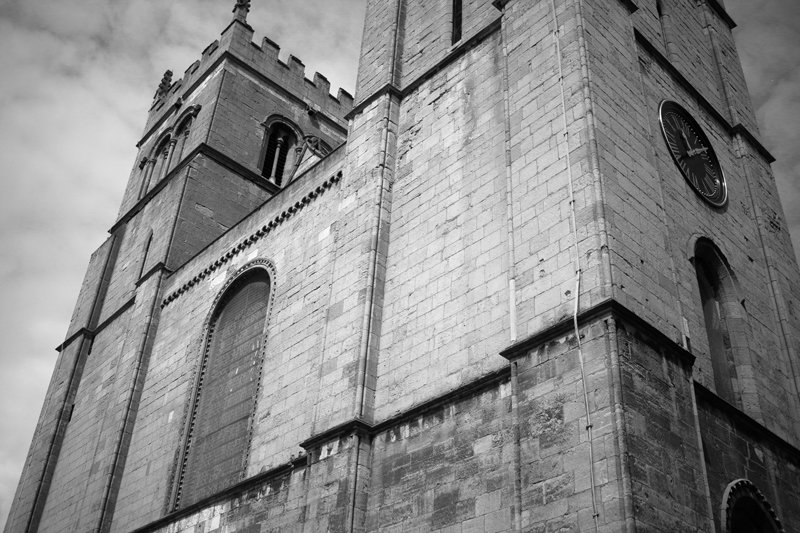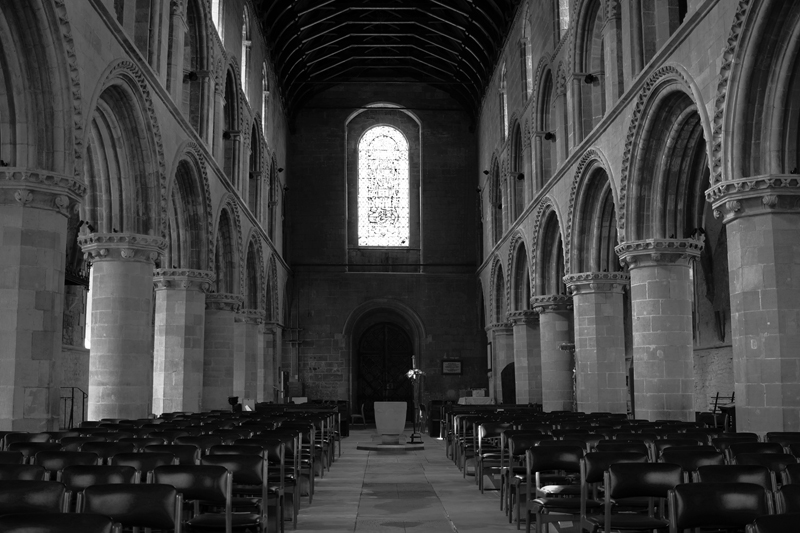‘I was interested to read about the connection between a genetic legacy and a specific religious building. Whilst at first it seems that these two concepts are not necessarily that connected, it is a really interesting proposition to make a case for this juxtaposition through research and presentation of a focused final outcome. When looking at the research and reflection section of your blog, I was expecting to see detailed research that touches on the various cultural, political, religious, historical, aesthetic ideas that are present within this concept. If this work had been done then I think that your final set of images would be much more focused.’
‘For example, I would say (and of course different people will have their own conceptual interpretation of these difficult ideas and it is important for you to develop your own through rigorous study) that the central issue when juxtaposing genetic legacy and religion could be focused on the debate between biologists and the church surrounding the idea of evolution (I will include a couple of examples of people you could look at in relation to these ideas). How could you photograph the church with these ideas in the background.’
There is a misconception from the very beginning of this piece of feedback. That the building was a religious place is not relevant. The idea that I have tried to convey is not an attempt to create any connection between genetic legacy and any aspect of religion. It’s about the building… how old it is, how it has lasted through the centuries, and how people can see it, and know that people created it. The religious aspect holds no interest for me and is not in any way relevant to my concept.
I have done no research on cultural, political, religious or historical aspects, because they aren’t relevant. The concept is entirely personal.
I will have no children. I need to leave something physical (art) behind.
These photos show something physical that was left behind, long ago, by other people. This is self-evident and needs no research. As the title of the assignment states ‘Photography Is Simple’… and for this particular assignment, that’s exactly what it is. It’s all about a gut feeling, or primal urge. Research would be a nonsense. The concept that my tutor describes is exactly the kind of thing I am opposed to in art. To use his own words ‘You have a healthy and positive cynical approach‘… Yes… for exactly that kind of concept. I find the very idea objectionable.
‘I am not really sure what you are trying to communicate about through your images? Also, do you have a rationale for choosing to remove the colour? Looking at your contact sheets, I can not see a reason for this.’
What I am trying to communicate through my images is explained in my assignment notes… it’s what I just described above. I suspect my tutor has not appreciated what my images are trying to convey, because of his misconception regarding some non-existent religious aspect.
The images are black and white for a couple of reasons… though why it would be expected that those reasons could be found in a set of contact sheets is beyond me.
That life is followed by death is a given. It’s not negotiable. Quite simply, it’s black and white. Then, on a purely aesthetic level, the use of black and white is stark, chilling, and a bit scary. That’s how the subject itself makes me feel. The idea that I will die, and in no time, be forgotten, fills me with horror.
‘In the written part of your submission, you say, ‘When I look at this building, especially when viewed from the adjoining graveyard, I get a very strong feeling of the people who existed here over the centuries, who built this place, who worshipped here, and are buried here.’ Now, this is a potentially interesting idea (particularly related to your idea of a personal genetic legacy) the problem is that I am not getting any sense of this through the pictures. In order to communicate the idea of the people who are buried there, could you have focused on the names of the graves? Could the differing shapes of the grave stones be presented as individual ‘personalities’? ‘
No. The concept I’m trying to put across is not about specific people. It’s not about individuals (other than myself). It’s about the idea that there were people in this place. That you can identify some of them is of interest, but they are not the focus. What I’m trying to depict is how solid objects can show that people existed. The names of those people don’t matter for this work. They would in fact distract from the idea. The viewer could potentially start pondering “who is this Bob Smith (or whoever), whose name I see on this gravestone? Where does he fit into all of this and what is his relevance?” No. That’s not what I’m trying to achieve at all. These photos are not about Bob Smith (or whoever).
‘In terms of the worshippers, could you photograph the people who still worship there (dwindling congregations are an interesting cultural issue)? Could you interview the local priest about this? The more information that you can collect, the more rich your final outcome will be.’
This has nothing to do with what I’m trying to achieve with this work.
‘Looking forward to the assessment, I would strongly advise you to strengthen your research and rework this series of images and re-shoot so that the finished set functions better as a coherent series of images that are communicating (NOT ILLUSTRATING) more specific ideas.’
…
‘To be clear, for assessment, I am not suggesting that you simply create a re-edit of your series and include these two examples, rather you should use your strong visual abilities to reshoot and focus on a more conceptually concise series.’
No. I feel my ideas are quite specific enough.
As I mentioned earlier, I feel that my tutor has misconstrued what it is I’m trying to represent with this piece of work. (This is further evidenced by his suggestion that I read materials regarding science / religion). That being the case, I can see how he would think my images don’t effectively convey the idea he has in mind. But what he is thinking is not what I am thinking, and this assignment is about MY ideas…. not my tutors.
I think what I actually need to do is take another look at my written piece of the assignment, to see if I have unintentionally placed more of an emphasis on the religious aspect of the setting than I had intended.
I have an interest in Norman cathedrals and churches, as I said, but not because of any religious aspect. It’s because they are, largely, the oldest standing man-made structures that are still in use. It’s about their age, not their purpose.
‘I hope that you understand this rather critical final feedback and take it in the positive way that it is intended. You have a strong visual base and some interesting ideas that will lead to some great work if you can increase the volume and specificity of your research methodology.’
I understand the purpose, and if I felt that my tutor had understood my concept, and wasn’t criticising me for not better representing what he thought I intended, rather than what I actually intended, I would take it as good advice.
Based on what I feel to be past and present misapprehensions regarding my ideas and concepts, my approach has been largely to ignore my tutor’s advice, and plough my own furrow. This may be a big mistake, but it’s mine to make.
Regarding research… I have a concern on this matter. I feel there is a disconnect between the level and detail of research that my tutor expects, when compared with the level that the course material has been pitched at. I may seek advice regarding this when I come to apply for my next modules.
It’s fair to say that if the level of research conducted before shooting is a factor in the final mark, then I should expect to achieve a poor mark for this piece. But the fact is, I simply didn’t know what kind of research I could do that would inform, enhance or improve the project. I didn’t want to study the work of other photographers, and be influenced by them, as there is always the pressure to ‘find your own voice’. I couldn’t see how studying historic details, or having discussions with the local vicar, would have any impact on the photographs that I took, as the concept was such a personal thing. It’s not about history, or religion. It’s about how I feel. So unless someone has done a detailed study on how I feel about not having children, and the things it makes me think about… research seems pointless.
I have read quite a few posts, on various forums, by students describing similar situations, where they disagree with the views expressed by their OCA tutors. Various opinions were expressed, some perhaps more valid than others, but one that I find most useful is that, regardless of the actual content or validity of the criticism, what such situations allow, is for students to practice defending their work.
Though maybe when I say ‘defending’, I mean ‘explaining more effectively’.
Art, by its nature, attracts critics, some more qualified than others. But if we are passionate about our work, at some point, we will need to defend or explain it. Not with a simple “You’re wrong!” or “You don’t know what you’re talking about”… but with a clear and considered argument.
I believe in the concept I was trying to represent in this assignment, and it would be wrong of me to alter it, based on feedback that I feel doesn’t show an appreciation of what I was trying to do. If I changed my assignment, it would not be art. It would just be a set of nice looking photos that I didn’t believe in.
If believing in (or respecting) myself as an artist means taking a lower mark, I’ll take it. These photos will be submitted as they stand.
I should stress (if I haven’t been clear enough) that I am not ignoring my tutor’s advice because I believe I know better than him. That would be ridiculous. It’s that his feedback gives me the impression that what he believes my work is about, is something other than what it is intended to be about. To alter it, in line with what he thinks it’s about, would not enhance the work in line with my actual intentions or purpose.
























